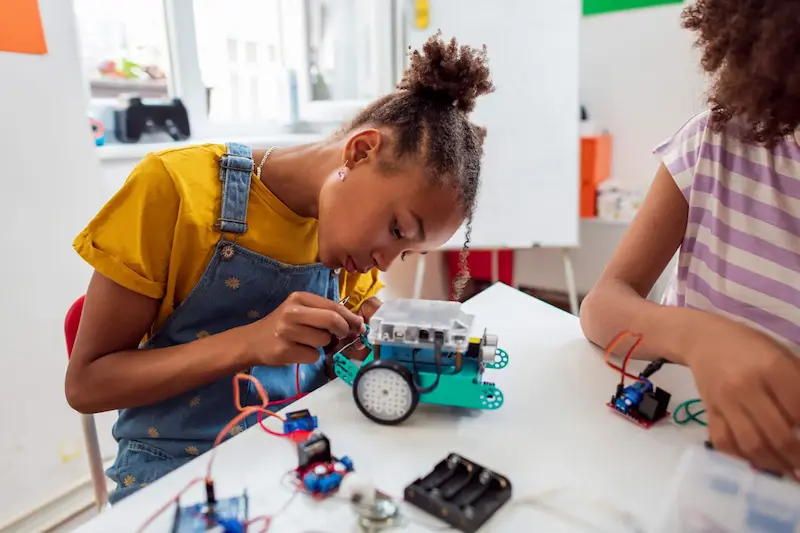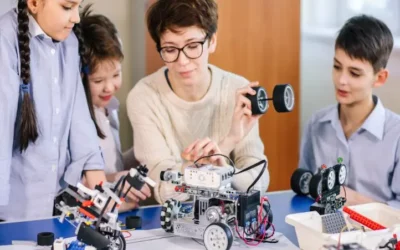The popularity of robotics classes has increased in recent years, attracting the imagination of people from all walks of life. The appeal lies in the fascinating world of robotics, where science fiction becomes reality, and the possibilities are endless.
Robotics is a area of computer science and engineering covering the creation, design, manufacture, operation and use of robots. Robots are automated machines capable of assisting humans in a number of settings, from manufacturing to working under the most dangerous circumstances that would be unsuitable for human life. The robotics experts are trying to achieve a wide range of tasks through the design of mechanical devices, capable of completing them efficiently.
We’re going to explore the world of robotics classes in this blog, looking at what they are, why they’re in demand, and what they offer.
Table of contents
The Benefits of Learning Robotics
Before we go to the topic of robotics classes, let’s take a moment to understand why they are popular and incredibly beneficial. Learning robotics is not about building cool gadgets; it’s a gateway to developing critical skills like problem-solving, creativity, and teamwork. It ensures that students are well prepared for the increasingly automated world by improving their technological literacy. In addition, as students often work in groups to tackle complex problems, robotics training encourages teamwork and cooperation.
Moreover, skill development in robotics prepares peoples for a future where automation and AI will play pivotal roles. These classes empower students to think innovatively and equip them with practical skills that can open doors to exciting careers.
Understanding Robotics
Defining Robotics
Do you know why robotics has the potential to lead the career in the future, because it is the intersection of engineering, computer science, and artificial intelligence. It involves the creation, operation, and study of machines capable of performing tasks autonomously or semi-autonomously.
These machines, often called robots, can be as simple as a vacuum cleaner or as complex as the Mars rovers. Robotics encompasses hardware and software, combining the mechanical and digital realms to achieve remarkable feats.
A Brief History of Robotics
Look back on the history of robotics, so that you can understand how important this class is. The journey began with ancient automatons, evolving from industrial robots of the 20th century to cutting edge robots of the 21st century. From production processes to healthcare and space exploration, robotics has made great strides in shaping our world.
Importance of Robotics in Today’s World
In the modern world, robotics is more than a niche field; it’s embedded in our daily lives. Robots assemble our cars, assist in surgeries, explore other planets, and even vacuum our floors. Understanding robotics is not just a hobby; it’s a skill that can make you a valuable contributor to various industries and innovation.

Educational Institutions Offering Robotics Classes
Schools
Robotics education starts young, with many primary and secondary schools now incorporating robotics into their curriculum. These classes introduce students to the basics of robotics, fostering interest and building foundational skills.
Colleges and Universities
Higher education institutions offer more advanced robotics courses for those seeking in-depth knowledge and specialization. These classes delve into complex robotics concepts and provide opportunities for research and innovation.
Specialized Robotics Schools
For individuals looking for a dedicated immersion into robotics, specialized schools offer comprehensive programs. These institutions focus solely on robotics education and often collaborate with industry experts to provide cutting-edge insights.
Online Robotics Courses
In the digital age, online robotics courses have gained prominence. These courses offer flexibility, allowing learners to study at their own pace and from anywhere in the world. They provide a wide range of topics, from robotics fundamentals to advanced applications.
DIY Robotics Learning Kits
DIY robotics kits have gained popularity among enthusiasts of all ages. These kits come with components and instructions, enabling individuals to build robots from scratch. They’re an excellent hands-on approach to learning robotics principles.

Curriculum Overview
Basic Concepts Covered
In robotics classes, students typically start with the fundamentals, including mechanics, electronics, and programming. They learn to assemble and control basic robots, gaining a solid understanding of how various components work together.
As students progress, they delve into more advanced topics such as artificial intelligence, machine learning, and computer vision. These classes challenge students to push the boundaries of what robots can achieve.
Hands-On Projects
One of the most exciting aspects of robotics classes is the opportunity to work on hands-on projects. Students apply their knowledge to design, build, and program robots that can perform specific tasks. These projects encourage creativity and problem-solving skills.
Age Groups and Skill Levels
Robotics Classes for Kids, Teens and Adults
Robotics classes for kids use age-appropriate materials and teaching methods to introduce children to the wonders of robotics. They focus on sparking curiosity and fostering a love for STEM (Science, Technology, Engineering, and Mathematics) subjects.
At Brightchamps, we’re thrilled to introduce our exciting robotics course for kids – RoboChamps. Our program is designed to spark the curiosity and creativity of young minds while equipping them with essential STEM (Science, Technology, Engineering, and Mathematics) skills.
RoboChamps is a hands-on, interactive learning experience where kids explore the fascinating world of robotics. Through fun and engaging activities, they learn to design, build, and program their own robots, fostering problem-solving abilities and nurturing their passion for technology.
Our experienced instructors are dedicated to providing a supportive and inclusive environment, ensuring that every child can thrive and reach their full potential. RoboChamps is not just a course; it’s a journey that empowers children to become the innovators and creators of tomorrow.
For teenagers, robotics classes become more structured and challenging. Teens can explore complex concepts and participate in competitions that test their robot-building skills.
Adults looking to enter the world of robotics can find specialized classes that accommodate their schedules and interests. These classes are often tailored to the specific needs and career goals of adult learners.
Most robotics classes offer different levels to accommodate various skill levels. Whether you’re a novice or an experienced enthusiast, there’s a class suitable for your needs, and if you need get educational guidance from experts.
Instructors and Experts
Qualifications of Robotics Instructors
Effective instructors are the cornerstone of a successful robotics class. They should have a strong background in robotics and teaching experience to guide students effectively. Many instructors also have industry experience, which provides valuable real-world insights.
In some robotics classes, guest lecturers and industry experts are invited to share their experiences and knowledge. These guest appearances offer students a glimpse into the latest trends and applications in the field.
Equipment and Tools
Common Robotics Tools
Robotics classes typically provide access to essential tools and equipment, including microcontrollers, sensors, actuators, and 3D printers. These tools are crucial for building and experimenting with robots.
Access to Robotics Labs
Some institutions have dedicated robotics labs equipped with state-of-the-art facilities. These labs provide students with a hands-on learning environment where they can bring their ideas to life.
In online robotics courses, students often use simulation software to design and test robots virtually. This allows for experimentation without the need for physical hardware.
How to Choose the Right Robotics Class
Factors to Consider and Questions to Ask
When selecting a robotics class, several factors should be taken into account, including the class format (in-person or online), curriculum, instructor qualifications, and available resources.
To make an informed decision, prospective students should ask questions about class objectives, prerequisites, assessment methods, and the level of technical support provided.
Learning Outcomes
Skills Acquired and Career Opportunities
Upon completing a robotics class, students gain a wide range of academic skills including programming, electronics, problem-solving, teamwork, and critical thinking. These skills are transferable to various industries.
Robotics education opens doors to diverse career opportunities, from robotics engineering and research to automation, artificial intelligence, and even entrepreneurship. The demand for skilled robotics professionals continues to grow across sectors and it will help to get career growth in profession.
The Future of Robotics Education
Emerging Trends
The field of robotics is constantly evolving. Future robotics education is likely to embrace emerging technologies like quantum computing, advanced materials, and bio-inspired robotics, shaping the way we interact with machines.
As robotics education advances, we can expect more immersive learning experiences, enhanced virtual reality simulations, and increased collaboration between educational institutions and industry partners.
Conclusion
In conclusion, robotics classes are more than just a trendy pursuit; they are a gateway to an exciting world of innovation and discovery. Whether you’re a curious child, a tech-savvy teenager, or an adult looking to expand your horizons, there’s a robotics class tailored to your needs.
The skills acquired in these classes are not only valuable in today’s job market but also essential for shaping the future of technology.
So, if you’ve ever wondered what robotics classes are all about, now is the perfect time to embark on this captivating journey. Dive in, and who knows, you might be the one designing the robots of tomorrow.
To get your hands on more such educational, parenting and free resources on coding, robotics, game development, etc., do check out the Brightchamps Blog Page now!
To get your hands on more educational and free resources on coding for kids, robotics for kids, financial education for kids, etc., do check out the BrightCHAMPS Page now!
Frequently Asked Questions
A1. The duration of a robotics class can vary widely depending on the level and format of the course. In general, introductory robotics classes, suitable for beginners, may span a few weeks or a few months. These classes focus on building fundamental skills and understanding basic concepts. On the other hand, more advanced robotics courses at the university level can extend over an entire semester or even a year. Additionally, some online robotics courses offer self-paced learning, allowing students to progress at their own speed. So, the typical duration can range from a few weeks to several months or more, depending on the specific class you choose.
A2. Absolutely! Robotics classes cater to individuals of all experience levels, including beginners. In fact, many robotics programs are designed with beginners in mind. These classes often start with the basics, teaching foundational concepts in mechanics, electronics, and programming. They provide a supportive learning environment where newcomers can explore the exciting world of robotics without prior experience. Whether you’re a child, a teenager, or an adult with no robotics background, there are beginner-friendly classes available to help you get started.
A3. The cost of enrolling in a robotics class can vary significantly depending on several factors. These include the level of the class (beginner, intermediate, advanced), the format (in-person or online), the duration of the course, and the institution or provider offering the class. Beginner-level robotics classes are often more affordable, while advanced or specialized programs may have higher tuition fees. Additionally, online courses may offer a cost advantage compared to in-person classes, as they eliminate the need for commuting and sometimes provide free or low-cost materials. Scholarships, grants, and financial aid may also be available to help offset the costs.
A4. Robotics classes are versatile and cater to a wide range of age groups. Typically, these classes are structured for kids, teenagers, and adults. For children, introductory robotics classes often start as early as elementary school age, around 8-10 years old. Teenagers can explore more advanced concepts, and there are specialized programs tailored to their interests and skill levels. Adults, including professionals looking to enhance their skills or change careers, can find robotics classes designed specifically for their needs. So, there’s no age limit when it comes to pursuing robotics education; it’s never too early or too late to start learning.


 We are an army of educators and passionate learners from BrightChamps family, committed to providing free learning resources to kids, parents & students.
We are an army of educators and passionate learners from BrightChamps family, committed to providing free learning resources to kids, parents & students.








